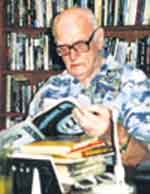|
|
||||
|
Keep reaching for the stars Interest in astronomy in Sri Lanka is undoubtedly ancient. The vastness of space and time was accepted by the ancient scholars of Buddhism. An ancient "map of the universe" - perhaps the oldest in existence, six feet in diameter, is carved on a rock cave in Ran Masu Uyana on the Tisawewa bund in Anuradhapura. Modern astronomical research in Lanka started in the late 19th century with planetary observations carried out by P. B. Molesworth (1867-1906). In 1901, he discovered the South Tropical Zone disturbance of Planet Jupiter using his 13-inch Newtonian reflector mounted at Fort Frederick, Trincomalee. The total solar eclipse across Lanka on June 20, 1955 created a great interest in astronomy. Then the Russians launched "Sputnik" on October 4, 1957, beginning the Space Age. Arthur C. Clarke and Mike Wilson had just finished exploring the "Great Barrier Reef" in Australia and settled down in Ceylon. The Ceylon Astronomical Association was founded on June 11, 1959, with Arthur C. Clarke as the first President and the late Herschel Gunawardene as the Hony. Secretary.
Membership of the Association was open to all. Members met mainly in their homes. Meetings were also held at the U.S.I.S., followed by the screening of the latest films on US space explorations. From 1960, the Association also published a quarterly journal named the Equatorial that carried contributions from astronomers from Lanka and abroad. The 1964 Industrial Exhibition saw the opening of the Colombo Planetarium to popularize astronomy among schoolchildren. A 10-inch telescope was obtained by Herschel Gunawardene and installed at the grounds of the Meteorological Department. In 1996, the Japanese Government gifted an 18-inch telescope, which is now located at the Arthur Clarke Center for Modern Technology in Moratuwa. A number of new astronomical groups were active for some years. The group at Subodhi under the guidance of Fr. Mervyn Fernando continues to help popularize astronomy and a number of schools now have Astronomical Societies. However, all is not well. There is no research group in Lanka capable of publishing an internationally recognized astronomy journal. All of the dozen or so Lankans who did a doctorate in astrophysics and continue in that field in their professional careers, do their research at foreign institutions. Molesworth's 13-inch telescope damaged during the insurrection of the late 1980s remains rusting in the dome on the grounds of the Colombo University. It reflects a lack of interest in astronomy among current Lankan undergraduates. For students who are interested, there are now many research projects they can do using astronomical observations obtained over the Internet or on DVD.
|
||||
Copyright © 2006 Wijeya Newspapers
Ltd. All rights reserved. |
